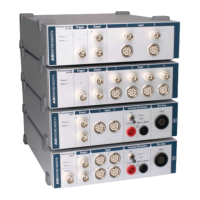PowerLab Teaching Series - Owner’s Guide
11
Analog Output
The PowerLab can generate a stimulus voltage through its analog output sockets
(marked Output + and –), giving positive, negative or di erential stimuli, depending
on the sockets used and the so ware settings. By default, the outputs are used for
complementary (di erential) stimulation, where Output + is positive and Output – is
negative.
When Output + is used, a positive stimulus voltage (set up in the so ware) gives a
positive voltage output, and a negative voltage a negative one. When Output – is used,
the voltage outputs are inverted. When both output sockets are used, the stimulus is
the di erence between the voltages at the positive and negative outputs: you could
generate up to a 20-volt pulse, using a setting of ±10 V.
You can use either the analog output or the isolated stimulator, but not both at once.
Analog Inputs
The analog inputs can record external signals from ±10 V down to the microvolt (μV)
range, without the need for additional external amplification.
Each analog input has an independent programmable gain amplifier with its own
filtering. Note that applying more than ±15 V to the analog inputs can damage the
circuitry.
The PowerLab 15T and 2/26 have two independent analog inputs marked Input 1 and 2;
the PowerLab 26T and 4/26 have four such inputs marked 1–4.
These 8-pin DIN connectors can be used as:
• Single-ended inputs, where the di erence between the signal and ground is
recorded.
• Di erential inputs, where the di erence between the positive and negative input
signals is recorded.
• Pod connectors, which allow the connection of ADInstruments pods, or those
transducers designed for direct connection.
On the 15T and /26 model PowerLabs, the impedance between the earthing stud
(ground connection) and the input connector grounds is close to zero.
Note that with the PowerLab 26T:
• ADInstruments front-ends, such as the FE221 Bridge Amp, can be used with
inputs 1 and 2 and inputs 3 or 4 by connecting them with the DIN-to-BNC
adaptor.
• When an ADInstruments pod or smart transducer is connected to either input 3
or 4, the corresponding Bio Amp input is turned o . Note that if you wish to use a
non-smart transducer to input 3 or 4 an MLAC22 or MLAC31 smart adapter must
be used.
WARNING:
PowerLab inputs
and outputs are
not electrically
isolated (except for
the Bio Amp input
and the Isolated
Stimulator outputs)
and so should nev-
er be connected to
human subjects.

